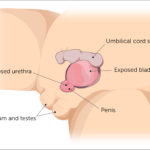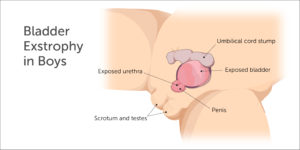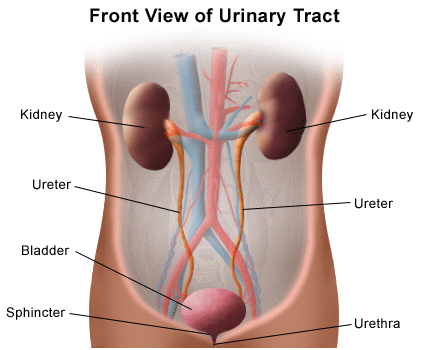 Bladder exstrophy is a rare condition that affects males and females. Only one out of every 20,000 babies born will have bladder exstrophy, and there is no known cause.
Bladder exstrophy is a rare condition that affects males and females. Only one out of every 20,000 babies born will have bladder exstrophy, and there is no known cause.
What is bladder exstrophy?
Bladder exstrophy (also called “classic exstrophy”) happens while a baby is developing inside the mother’s womb. The bladder develops inside out and is visible when the baby is born. Since the bladder is exposed to the outside, urine constantly trickles onto the skin, which may cause irritation. Health care providers who treat children with bladder exstrophy work closely with both patients and caregivers to prevent skin problems.
This condition primarily affects the bladder but may affect other parts of the body, such as the:
- Upper and lower urinary tract
- Muscles (pelvic and abdominal)
- Bones (pelvis and hip)
- Digestive system
- Reproductive tract
- External genitalia (private parts that you can see)
Epispadias and cloacal exstrophy are conditions that are closely related to bladder exstrophy.
 Other conditions closely related to bladder exstrophy
Other conditions closely related to bladder exstrophy
What is epispadias?
Epispadias is almost always present with bladder exstrophy; however some babies are born with epispadias without bladder exstrophy. Epispadias occurs when the urethra (tube that drains urine from the bladder to the outside of the body) does not fully close during development. Because the tube is open where it should be closed, urine can leak from wherever the opening occurs. In boys, the opening is usually on the top of the penis and not at the tip.
What is cloacal exstrophy?
Cloacal exstrophy happens when a baby is born with a portion of their intestines/digestive tract and the bladder on the outside of the abdomen (belly). The bladder is divided in half with each side attached to the intestines, which are located in the middle. This is more serious than bladder exstrophy or epispadias because it also affects the development of the pelvic bones and sometimes the spinal cord.
What causes bladder exstrophy/epispadias?
Some studies have found that this condition may be inherited, but the gene has not been identified. A baby born to a parent who had exstrophy has a 1/77 chance of having exstrophy.
The urinary system: Knowing the basics of how the urinary system usually works can help you understand the treatments for bladder exstrophy.

Here are the parts of the urinary system and what they do:
Kidneys: A pair of purplish-brown organs located below the ribs toward the middle of the back.
Their function is to:
- Remove liquid waste from the blood in the form of urine
- Keep a balance of salts, water, and other substances in the blood
- Make “erythropoietin,” a hormone that helps make red blood cells form
Ureters: Two narrow tubes that carry urine from the kidneys to the bladder. If urine cannot drain or is allowed to stand still, bacteria can grow and a kidney infection can develop or pressure from fluid build-up can lead to symptoms such as nausea, vomiting, and abdominal or back pain.
Bladder: A balloon-shaped organ in the lower abdomen (belly) that stores urine. When a person passes urine or “pees,” the bladder muscle squeezes to empty the urine through the urethra.
Sphincter muscles: Two circular muscles that help keep urine from leaking by closing tightly like a rubber band around the opening of the bladder. The sphincter muscles relax when a person urinates (pees).
Nerves in the bladder: The nerves inside the bladder signal the body when it’s time to urinate (pee) or empty the bladder
Urethra: A tube that is attached to the bladder and allows urine to leave the body
What are the treatments for bladder exstrophy?
Surgery: The first treatment for bladder exstrophy is surgery to close and place the bladder inside the body. The surgery is almost always done early in life, soon after a baby is born, within the first 2-3 months of life.
After surgery patients require ongoing care, which may include:
- Medications
- Catheterization (passing a tube to empty urine from the bladder)
- Physical therapy to strengthen certain muscles to tighten and relax to allow urine to pass
- More surgery is sometimes needed
The goals of surgical treatment for bladder exstrophy are:
- Normal kidney function
- Improved bladder function
- Urinary continence; no leakage of urine
- Making sure that the patient and their parents are satisfied with the appearance and function of their genitalia (private parts)
Is medicine also used to treat bladder exstrophy?
Many people with bladder exstrophy need to take medicine to help their bladder work correctly. A person may also need to take medicine to prevent bladder and kidney infections.
If you have bladder exstrophy, it’s important to take your medications as prescribed by your health care provider, even if you’re feeling fine. This is because many of the medications prevent problems from happening.
Two main types of medications used for teens and young adults with bladder exstrophy are:
- Anticholinergics: These medicines relax the bladder, help the bladder hold urine longer, and take pressure off of the kidneys.
- Antibiotics: These medicines treat and prevent infections of the urinary system. Some patients require long term antibiotics.
Catheterization: Many patients with bladder exstrophy have trouble emptying their bladders completely and require help using catheterization.
Catheterization involves passing a soft tube through the urethra (or a surgically created opening in the abdomen) so that urine can be emptied from the bladder. It’s usually done on a schedule, multiple times per day (similar to if you were peeing on your own). It’s important to stay on the schedule your health care provider gives you, even if your bladder doesn’t feel full. It is also important to catheterize before the set time if your bladder feels full earlier.
How does bladder exstrophy and other related conditions affect my penis?
Most boys and men with exstrophy have a shortened penis. Some young men also have widening and/or curvature of the penis.
Going to the bathroom in public: Many guys with exstrophy prefer to use a stall instead of a urinal to “cath” (catheterize). If you have bladder exstrophy, don’t feel ashamed of using a stall – most guys in the same situation use one too.
If you use a catheter, one easy way to keep it private is to fold the tube and place it in a snack-sized plastic bag that can be sealed and carried in a backpack or pocket.
Sexual Activity for Guys with Bladder Exstrophy:
- Most guys with bladder exstrophy are able to have a pleasurable sex life and are able to have children.
- Some guys prefer specific sexual positions and/or medicine to help them get a full erection.
- Sometimes guys may have trouble using a condom due to the shape of their penis. If you’re having trouble, talk to your health care provider.
Bladder Exstrophy Health Tips:
Following your treatment plan will:
- Lessen your chances of getting a urinary infection and keep your kidneys working well
- Prevent unscheduled clinic or ER visits and overnight hospital stays
- Avoid having to take extra medicine
- Lower the risk of bladder rupture
- Help you feel well so that you can participate in fun activities
Ways to keep your bladder healthy:
- Drink plenty of fluids especially when active with sports
- Catheterize and/or urinate at least 5 times per day
- Empty your bladder before going on a long car ride
- Empty your bladder before and after playing sports or other physical activities.
- Take medications as instructed, even if you feel fine
- Flush your bladder with saline or antibiotic wash (only if your health care provider tells you to)
Call your health care provider right away if you have any of the following symptoms:
- Fever greater than 101.5°F
- You can’t empty your bladder by urinating or catheterizing
- Severe pain in your abdomen (belly) or back
- Nausea or vomiting that doesn’t go away
- You’re unable to have a bowel movement (poop) for more than 2 days
If you have any of the symptoms listed above and you can’t reach your health care provider, go to the nearest emergency room.
Additional Resources:
- Boston Children’s Hospital: Bladder Exstrophy Program
- Boston Children’s Hospital: Urology Department
Source: Read Full Article





